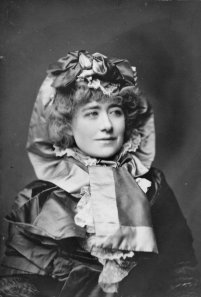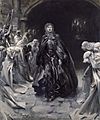Ellen Terry facts for kids
Quick facts for kids
Dame
Ellen Terry
|
|
|---|---|
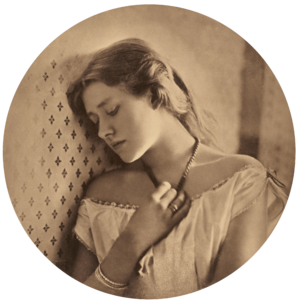
Portrait by Julia Margaret Cameron, 1864
|
|
| Born |
Alice Ellen Terry
27 February 1847 Coventry, Warwickshire, England
|
| Died | 21 July 1928 (aged 81) Small Hythe, Kent, England
|
| Spouse(s) |
Charles Clavering Wardell
(m. 1877, divorced)James Carew
(m. 1907; sep. 1909) |
| Partner(s) | Edward William Godwin (1868–1875) |
| Children |
|
| Signature | |
 |
|
Dame Ellen Terry (born Alice Ellen Terry, 27 February 1847 – 21 July 1928) was a very famous English actress. She was one of the most important stars on stage in the late 1800s and early 1900s.
Ellen came from a family of actors. She started performing when she was just a child. She acted in plays by William Shakespeare in London. As a teenager, she toured across Britain. At 16, she married artist George Frederic Watts. They separated after a year. She soon returned to acting. Later, she had two children, Edith Craig and Edward Gordon Craig, with architect Edward William Godwin. She took a break from acting for six years to raise her children.
In 1874, Ellen Terry returned to the stage. People quickly praised her acting, especially in Shakespeare's plays. In 1878, she joined Henry Irving's theatre company. She became his main actress for over twenty years. Many considered her the best Shakespearean and comedy actress in Britain. Two of her most famous roles were Portia in The Merchant of Venice and Beatrice in Much Ado About Nothing. She and Henry Irving also had very successful tours in America and Britain.
In 1903, Ellen Terry took charge of the Imperial Theatre, London. She focused on plays by George Bernard Shaw and Henrik Ibsen. This theatre venture did not make money. So, Ellen Terry started touring and giving lectures. She continued to act successfully until 1920. She also appeared in films from 1916 to 1922. Her amazing career lasted for almost seventy years.
Contents
Early Life and First Steps on Stage
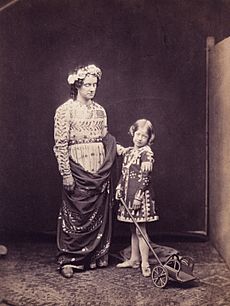
Ellen Terry was born in Coventry, England. She was the third child in a family of actors. Her parents, Benjamin and Sarah, were comedy actors. They worked in a touring theatre company. Ellen had ten brothers and sisters. At least five of them became actors too. Her sisters Kate and Marion were also very successful on stage.
Ellen first appeared on stage when she was nine years old. She played Mamillius in Shakespeare's The Winter's Tale. This was at the Princess's Theatre, London in 1856. She also played Puck in A Midsummer Night's Dream that same year. She continued acting at the Princess's Theatre until 1859. During summer breaks, her father put on shows. These were first in London, then on tour.
In 1859, she acted in a comedy called Nine Points of the Law. For the next two years, Ellen and her sister Kate toured Britain. They performed short plays and sketches. Their parents and a musician traveled with them.
From 1861 to 1862, Ellen worked at the Royalty Theatre in London. She acted with other rising stars. In 1862, she joined her sister Kate in Bristol. There, she played many different roles. These included singing and dancing parts. She also acted in famous plays like Othello. In 1863, she returned to London. She joined a company at the Haymarket Theatre. She continued to play Shakespearean roles. She also acted in comedies.
Marriage and a Break from Acting

Ellen Terry had a busy personal life. While acting at the Haymarket Theatre, she and her sister Kate had their portraits painted. The artist was George Frederic Watts. He was a very famous painter. One of his well-known paintings of Ellen is Choosing. It shows her deciding between different values in life. Watts also painted her as Ophelia and Watchman. He asked Ellen to marry him. He was much older than her. Ellen was impressed by his art and lifestyle. She also wanted to please her parents.
Ellen and Watts married on 20 February 1864. She was almost 17, and he was 46. Ellen felt a bit uncomfortable in this marriage. She separated from Watts after only ten months. But during this time, she met many important people. These included poets Robert Browning and Alfred, Lord Tennyson. She also met prime ministers William Ewart Gladstone and Benjamin Disraeli. Because of Watts's paintings, she became a popular figure. Poets and painters of the Pre-Raphaelite movement admired her.
She returned to acting by 1866. In 1867, Ellen performed in several plays. She acted opposite Henry Irving for the first time. This was in Katherine and Petruchio. It was a short version of The Taming of the Shrew.
In 1868, Ellen started a family with architect Edward William Godwin. She admired his artistic taste. They moved to a house in Harpenden. Ellen stopped acting for six years. She had a daughter, Edith Craig, in 1869. Her son, Edward Gordon Craig, was born in 1872. The family chose the last name Craig for the children. This was to help them avoid social difficulties at the time.
By 1874, Ellen and Godwin's relationship changed. Godwin was busy with his work and money problems. They separated in 1875. But Godwin still designed costumes for Ellen. In 1874, Ellen returned to acting. She played several roles in plays by Charles Reade. She also performed at the Crystal Palace. She acted with Charles Wyndham.
Becoming a Star: Shakespeare and Henry Irving
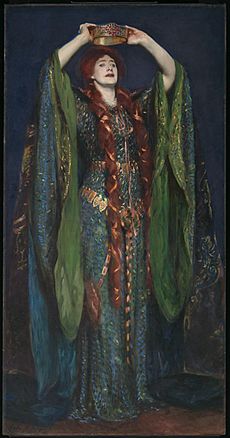
In 1875, Ellen Terry gave a highly praised performance. She played Portia in The Merchant of Venice. This was at the Prince of Wales's Theatre. The writer Oscar Wilde even wrote a poem about her in this role. She played Portia many times throughout her career. Her last performance as Portia was in 1917.
In 1876, she acted in The School for Scandal. She also played the main role in Olivia. This was at the Royal Court Theatre. In November 1877, she married Charles Clavering Wardell. He was an actor and journalist. They separated in 1881. After this, she became close with her parents again.
In 1878, Ellen Terry, then 30, joined Henry Irving's company. She became his main actress at the Lyceum Theatre, London. She started with Ophelia in Irving's Hamlet. Soon, she was seen as the top Shakespearean actress in Britain. She and Irving worked together for over 20 years. They left the Lyceum in 1902.
Their 1879 show of The Merchant of Venice ran for 250 nights. This was a very long run for the time. They had many successes with Shakespeare's plays. They also performed works by other famous writers. Critics praised Ellen Terry's acting. One newspaper called her performance "inimitable charm." They said it was full of "natural grace."
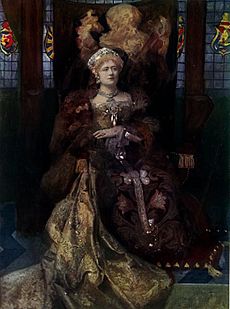
Some of her most famous roles with Irving included Ophelia and Portia. She also played Beatrice in Much Ado About Nothing. This became one of her signature roles. Other important parts were Juliet in Romeo and Juliet and Viola in Twelfth Night. She also played Lady Macbeth in Macbeth in 1888. In 1892, she was Queen Katherine in Henry VIII.
Ellen Terry first performed in America in 1883. She played Queen Henrietta. She went on six more tours in North America with Irving. She played many of her famous roles there. People often wondered if Irving and Terry were more than just professional partners. After Irving died, Ellen Terry said they had been in love for a time. Irving was separated from his wife. Terry had separated from Wardell. Irving was also a godfather to her children. They traveled on holidays together. Irving wrote kind letters to her.
In London, Ellen Terry lived with her children and pets. She had country homes too. In 1900, she bought a farmhouse in Small Hythe, Kent. She lived there for the rest of her life. Her son, Edward, joined the Lyceum company as an actor. He later left acting to study art. Her daughter, Edith, also acted at the Lyceum. She later became a stage director and costume designer. She designed costumes for her mother and other actresses.
New Ventures and Later Years
In 1902, Ellen Terry played Mistress Page in The Merry Wives of Windsor. In the 1890s, she became friends with writer George Bernard Shaw. They wrote many famous letters to each other. Shaw wanted to start a theatre project with her. In 1903, Ellen Terry started her own theatre company. She took over the Imperial Theatre, London. This was after Henry Irving left the Lyceum.
At the Imperial Theatre, Ellen had full artistic control. She could choose the plays. She focused on plays by Shaw and Henrik Ibsen. One play was Ibsen's The Vikings in 1903. In this, Ellen played the warrior Hiordis. Running the theatre was not a financial success for Ellen. She had hoped it would show off her children's talents. Her son was a set designer, and her daughter designed costumes.
After this, she toured England. She performed in cities like Nottingham and Liverpool. In 1905, she played the main role in J. M. Barrie's Alice-Sit-by-the-Fire. Henry Irving died in 1905. Ellen was very sad and left the stage for a short time.
She returned to the theatre in April 1906. She played Lady Cecily Wayneflete in Shaw's Captain Brassbound's Conversion. She toured successfully in this role. On 12 June 1906, her 50th year on stage was celebrated. A huge gala performance was held at the Drury Lane Theatre. Many famous performers took part. This event raised £6,000 for Ellen Terry. She then played Hermione in The Winter's Tale. In 1907, she toured America. During that tour, she married her co-star, James Carew. He was 30 years younger than her. They separated after two years but never divorced. Her acting career remained strong.
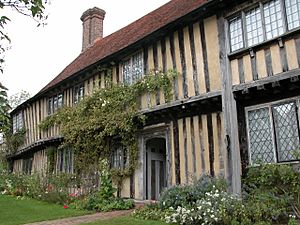
In 1908, she played Aunt Imogen in a fairy play. In 1909, she played Nance Oldfield in a play directed by her daughter Edith. In 1910, she toured Britain and the US. She acted, gave recitations, and lectured on Shakespeare's heroines. In 1911, she recorded scenes from five Shakespeare roles. These are the only known recordings of her voice. From 1914 to 1915, Ellen Terry toured Australia, the US, and Britain. She continued to recite and lecture. While in the US, she had eye surgery. It was only partly successful. In 1916, she played Darling in The Admirable Crichton. During World War I, she performed in many charity shows.
Films and Final Years
In 1916, Ellen Terry appeared in her first film. It was called Her Greatest Performance. She continued to act in London and on tour. She made a few more films until 1922. These included Victory and Peace (1918) and The Bohemian Girl (1922). During this time, she kept lecturing on Shakespeare. She also performed scenes from Shakespeare plays in music halls. Her last full stage role was the Nurse in Romeo and Juliet in 1919.
She retired from the stage in 1920 and from film in 1922. She made one last stage appearance in 1925. She played Susan Wildersham in a fairy play.
In 1922, the University of St Andrews gave Ellen Terry an honorary degree. In 1925, King George V made her a Dame Grand Cross of the Order of the British Empire. She was only the second actress to receive this high honor for her work. In her last years, she slowly lost her eyesight. She also suffered from memory problems.
Death and Lasting Impact
Ellen Terry passed away on 21 July 1928. She was 81 years old. She died at her home in Smallhythe Place, Kent. Her son, Edward, said she looked very young and beautiful after she passed. Ellen Terry was cremated. Her ashes are kept in a special chalice. It is in the actors' church, St Paul's, Covent Garden, in London.
After her death, the Ellen Terry Memorial Museum was opened. Her daughter, Edith Craig, created it. It is at Smallhythe Place, the house Ellen bought. The National Trust took over the museum in 1947.
Ellen's daughter, Edith Craig, became a theatre director. She also designed costumes. She was an early supporter of women's right to vote. Ellen's son, Edward Gordon Craig, became an actor and designer. He also founded a theatre school in Italy. The famous actor John Gielgud was Ellen Terry's great-nephew. Illustrator Helen Craig is Ellen Terry's great-granddaughter.
Coventry University has a collection of Ellen Terry's belongings. The university also has a building named after her.
Images for kids
-
Drawing by Sargent for Terry's golden jubilee programme, 1906
See also
 In Spanish: Ellen Terry para niños
In Spanish: Ellen Terry para niños
- Neilson–Terry Guild of Dramatic Art
- Terry family


